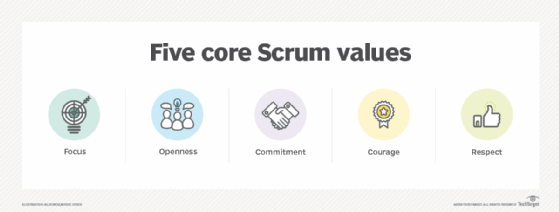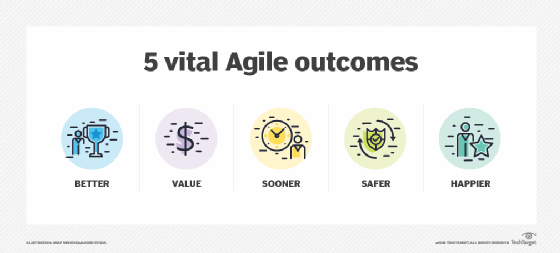
Agile versus Scrum: What's the difference?
What's the difference between Agile and Scrum? What are their similarities? Learn how to compare and contrast these two popular software development frameworks and methodologies.
In a modern DevOps environment, you may hear the terms Agile and Scrum used interchangeably, which is understandable given their similarities. Still, practitioners must be aware of their differences.
The key difference between Agile and Scrum is that Agile is a philosophy about how to successfully deliver software to a customer, while Scrum is a proven methodology for software development teams to follow.
Agile Manifesto versus the Scrum Guide
Everything you need to know about the differences between Agile and Scrum can be found by comparing the Scrum Guide and the Manifesto for Agile Software Development. These are the defining documents for Agile and Scrum, and should be the baseline for any technical comparison.
The Agile Manifesto, signed in 2001 by Martin Fowler, Jon Kern, Jeff Sutherland and 14 others, attests to four fundamental values:
- individuals and interactions over processes and tools;
- working software over comprehensive documentation;
- customer collaboration over contract negotiation; and
- responding to change over following a plan.
Agile's priorities and values
The Agile Manifesto also includes 12 principles of Agile software development. These are short statements about how teams should best approach software development, such as: "Our highest priority is to satisfy the customer through early and continuous delivery of valuable software."
IT professionals who read the Agile Manifesto will be surprised by its brevity. In total, the discussion of the Agile Manifesto's four values and 12 principles is fewer than 300 words.
The guiding hand of Scrum
Pioneered by Ken Schwaber and Jeff Sutherland, Scrum's origins date back to the early 1990s, based on the practices of empiricism and lean thinking. The Scrum Guide, published in 2010, officially outlined the steps an organization must follow to implement Scrum.
The Scrum Guide is more verbose than the Agile Manifesto, though also relatively succinct at only 14 pages and fewer than 5,000 words. Despite the Scrum Guide's brevity, it effectively describes:
- how developers, product owners and Scrum Masters should interact;
- how to manage a software development sprint from planning through to the retrospective; and
- the various Scrum artifacts a team should create to help track and monitor progress.
The Scrum Guide is not an instruction manual on how to build software. As its name implies, it is simply a guide. Scrum enables self-organized teams to be creative and discover the software development practices that work best for them, so long as the adopted rituals are in line with the guide.

Scrum and Agile compared
A comparison between Agile and Scrum reveals that Agile simply describes, at a fairly abstract level, the thoughts and ideas that should drive and motivate a productive software developer. In contrast to Agile, Scrum provides a concrete set of steps to follow in order to continuously deliver software to the customer.
The Agile Manifesto does not discuss how to implement its principles or values.
Agile provides no instructions on how a team might develop an application in accordance with the values and principles the manifesto espouses. The manifesto simply defines the basic philosophy that drives the behavior of an Agile software developer.
In contrast to the philosophical nature of Agile, Scrum is a methodology.
Scrum is a software development framework that describes how different participants within an organization should work together to most effectively and efficiently develop and deliver software.
| Scrum vs. Agile: The facts |
||
|
|
Scrum |
Agile |
| Inception |
Early 1990s |
2001 |
| Founding document |
||
| Creators |
Jeff Sutherland and Ken Schwaber |
17 signatories including Kent Beck, Jon Kern and Dave Thomas |
| Type |
Framework |
Philosophy |
| Alternatives |
Kanban, Lean development, Scrumbut |
Waterfall |
| Prioritizes |
Continuous improvement |
Continuous delivery |
Scrum and Agile differences
While they are similar in many respects, here are five key differences between Agile and Scrum:
- Scrum is a methodology, while Agile is a philosophy
- Scrum provides an implementation framework, while Agile does not
- Scrum describes three key roles, while Agile emphasizes self-organizing teams
- Scrum has five living values, while Agile has four fundamental tenants
- Scrum has three pillars, while Agile has 12 principles
Agile and Scrum similarities
While there are many axes upon which to contrast Agile versus Scrum, there are many important similarities as well.
Although Scrum's inception predates Agile by a decade, Scrum is considered a methodology that embraces the Agile philosophy. If you do Scrum properly, you are by extension, doing Agile as well. That's because the Scrum Guide embraces the ideas and values articulated in the Agile Manifesto.
For example, the Agile Manifesto strongly emphasizes the "early and continuous delivery of valuable software." Similarly, Scrum dictates short software development sprints that incrementally produce software for the customer to evaluate and review.

Scrum and Agile in collaboration
Agile also emphasizes that "business people and developers must work together daily throughout the project." Comparatively, Scrum describes the different artifacts a product owner can use to communicate their goals in a transparent and properly understood fashion.
Scrum encourages developers to live by five values: commitment, focus, openness, respect and courage. These are articulated in different ways in the Agile Manifesto and its 12 principles.
Similarly, the three pillars of Scrum, namely transparency, inspection and adaptation, are echoed by Agile statements that prioritize: "responding to change over following a plan," and demand that "at regular intervals, the team reflects on how to become more effective, then tunes and adjusts its behavior accordingly."
Despite their differences, Agile and Scrum are more of a complement to one another than they are competitors, which is why people often utter the terms Scrum and Agile in the same breath. After all, Agile developers who use Scrum-based methods have a long history of software development success.
More about Agile and Scrum
Once you understand how Agile and Scrum are similar and different, the next step is to determine how to put either or both of them into practice in your organization. Here are some themes to dig into:








